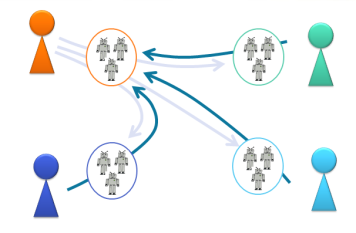AI as an Interface to Business Process
Blog: Collaborative Planning & Social Business
Dag Kittlaus demonstrated Viv last week which the business software world should pay attention to. “Viv” is a conversational approach to interacting with systems. The initial presentation talks about personal applications, but there are even greater opportunities in the workplace.
What is it?
If you have not yet seen it, then take a look at the Techcrunch Video. It is billed as a artificial intelligence personal assistant. Dag Kittlaus brought Siri to Apple to provide basic spoken language recognition to the iPhone. Viv goes a lot further. It takes what you say and start creating a map of what you want. As you say more, it modifies and refines the map. It taps information service providers, and these are combined in real time based on a semantic model of those services.
This is precisely what Nathaniel Palmer was presenting in his forward looking presentation at the bpmNext conference, and coincidentally something I brought up as well. Businesses moved from big heavy equipment, to laptops, and then to smart phones. Mobile is so last year! The devices got more portable, and the graphical user interface got better over the years, but the paradigm remained the same: humans collect the information together, and submit it to the system, to allow the system to process it. You write an email, edit to final form, and then send it. You fill out an expense report, and then submit it.
A conversational UI is very different. You have a single agent that you contact by voice message, text message, email and yes probably also by web forms, which hen in turn interfaces with the system software. It learns about you, and the kind of things you normally want, so that it can understand what you are talking about, and translate to the relatively dumber systems.
I was not that impressed
All of the examples were simply, one-off requests. Ask for weather, and ask a more complicated query which shows some nice parsing capability, but it is still just a single query with a single answer. Dynamic program generation? Software that writes itself? Give me a break: every screen generator, every application generator, generates a program that executes. This is a bit hyperbolic. The important thing is not that it creates a sequence of steps that satisfy the intent, but that it is able to understand the intent in the first place.
Order flowers. I could call the one person and order flowers. I can order a Uber car without needing an assistant. Booking a hotel is only a few mouse clicks. That is always the problem with demonstrations — they have to simple enough to grasp, short enough to complete in a few minutes, but hopefully compelling enough to understand the potential.
The most interesting part is after he has the list of flowers, he simply says “what about tulips” and Viv refined the situation. This shows the power of the back and forth conversation. The conversation constitutes a kind of learning that works together with you to incrementally get to what you want to do. That is the news: Viv has an impressive understanding about you and what you mean with a few words, and it extends that understanding on a case by case basis.
What is the Potential?
One of the biggest problems with BPM is this idea that you have to know everything at the time that the process starts. You have to put all your expenses into the expense report for processing. You need to fill in the complete order form before you can purchase something. As we illustrated in Mastering the Unpredictable, many business have to start working long before they know all the data. The emergency room has to accept patients long before they know what care is needed.
The conversational approach to applications will radically transform the ability of software to help out. Instead of being required to give the full details up front, you can tell the agent what you know now. It can start working on part of that. Later, you tell it a little more, maybe after reviewing what it had found so far. If it is heading down the wrong path, you steer it back in the right direction.
I personally hate forms that that ask for all the potential bit of information that might be needed somewhere in the process. Like at the doctor’s office where you fill in the same details every time, most of which are going to be needed on this visit, but there is a spot there just in case. A conversational approach would allow me to add information as it is needed.

With a group of people this starts to get real interesting. The doctor is unsure on the direction to go with a patient, so they bring an expert into the conversation. That expert could start asking questions about the patient. The agent answers when it can, but it also can pass those questions on to the doctor and the patient. The conversation is facilitated by the map that represents the case so far. The agent learns what needs to be done, and over time can facilitate this interaction by learning what the various participants normally mean by their spoken words.
It is not that far fetched. It will radically change the way we think about our business applications. It is certainly is disruptive. This demonstration by Viv makes it clear that this is already happening today. You might want to buckle your seat belts.
Leave a Comment
You must be logged in to post a comment.







